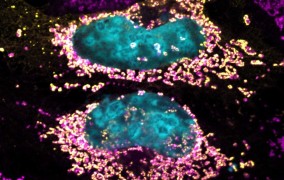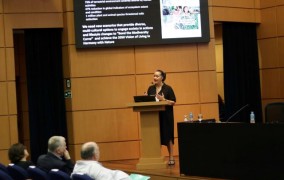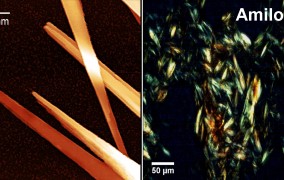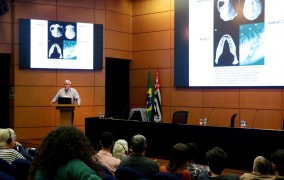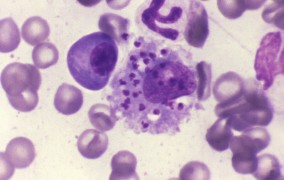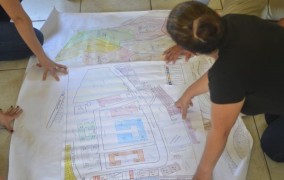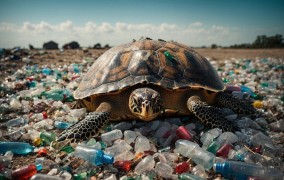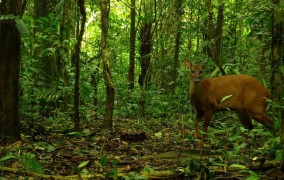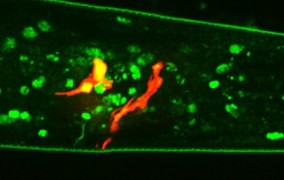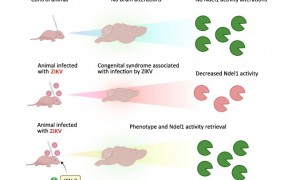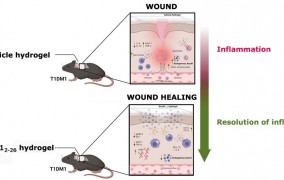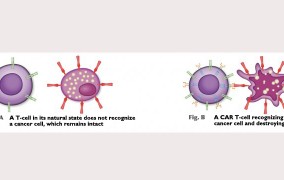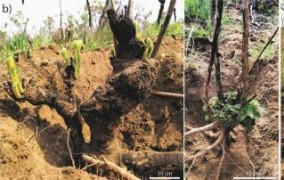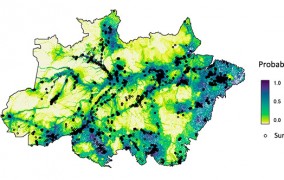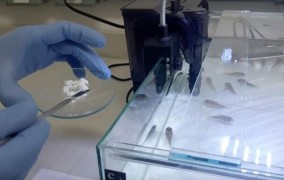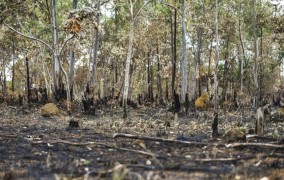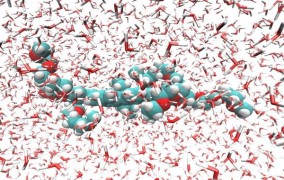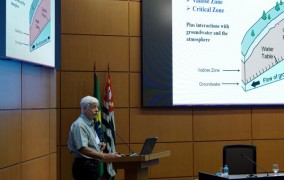
Search: 4362 news
-
Customizable corporate training system uses technology, immersion and interactivity
2023-11-08The platform was developed by a startup supported by FAPESP. It uses an adult learning methodology that leverages motivational techniques and customization. -
Molecule tested at University of São Paulo proves able to mitigate heart failure
2023-11-08Results of trials involving animals, cell cultures and human heart tissue are reported in the European Heart Journal. The study was conducted by researchers at USP in partnership with a biopharmaceutical firm, offering hope to 2 million Brazilians who suffer from the disease. -
Study reveals bacterial protein capable of keeping human cells healthy
2023-11-08An article published in PNAS by Brazilian and Australian researchers describes a hitherto unknown protein with anti-oxidizing properties secreted by Coxiella burnetii, a Gram-negative intracellular bacterium, pointing to possible treatments for auto-immune diseases and even cancer. -
Open data sharing is essential to pursuit of sustainability solutions
2023-11-08This was a consensus among representatives of funding agencies in the Americas who met virtually in October under the aegis of the Global Research Council. A previous event discussed funding for research relating to artificial intelligence in Latin America. -
South African researcher presents novel ways of thinking about the relations between society and ecosystems
2023-11-08Laura Maureen Pereira delivered the Seventh 2023 FAPESP Lecture on “Why we need transformative scenarios for people and nature”. -
Chemical process makes peptide acquire structure similar to amyloid plaques found in neurodegenerative diseases
2023-11-01Highlighted on the cover of the journal Biochemistry, a study by Brazilian researchers shows that a chemical change called pyroglutamination can occur spontaneously during peptide synthesis. The discovery has implications for laboratory experiments and research on Alzheimer’s, Parkinson’s and other diseases associated with the formation of amyloid aggregates. -
“We are not so much trying to improve our understanding of human evolution as trying to reduce our ignorance about it”
2023-11-01This is how Bernard Wood, one of the foremost paleoanthropologists alive, summed up his philosophy in the Sixth 2023 FAPESP Lecture. -
Test detects co-infection by novel species of parasite in severe cases of visceral leishmaniasis
2023-11-01The test developed by Brazilian researchers accurately identifies the causative agent in less than two hours, so that treatment can be properly targeted. Brazil is seeing a growing number of cases of co-infection by protozoans Leishmania infantum and Crithidia. -
Novel portable device weighing less than 1 kg helps harbor pilots maneuver large vessels into port
2023-11-01High-precision maneuvering support system with integrated hardware and software developed by a startup supported by FAPESP transmits dynamic information in real-time via a smart platform. -
Research funding disbursed by FAPESP rose 16.7% in 2022 compared with the previous year
2023-11-01FAPESP increased research funding opportunities by creating new programs and new partnerships, according to its 2002 Annual Report. -
Better access to diagnostic tests raises incidence of thyroid cancer in more affluent areas
2023-11-01A study compared geographical and socioeconomic dimensions of the disease in São Paulo and the Barretos region. Incidence was far higher in the former but mortality rates were similar, suggesting overdiagnosis in specific areas and social groups. -
Method involving citizen participation is effective to address risks of environmental disaster
2023-10-25A research project showed that mobilizing citizens in flood-prone areas improves data collection and increases resilience. -
Products made of plastic falsely claimed to be biodegradable are on sale at Brazilian supermarkets
2023-10-25Researchers at the Federal University of São Paulo analyzed allegedly biodegradable plastic items sold by 40 supermarkets and found most to be oxo-degradables, banned in several countries because they contribute significantly to microplastic pollution. Bills currently before Brazil’s Congress would regulate the sale of such products. -
Subsistence poaching has little impact on biodiversity in the Amazon’s environmental protection areas
2023-10-25A study conducted in sustainable-use reserves shows that local game species become less abundant about 5 kilometers away from the nearest human community, but the negative effects of anthropic activity can be mitigated by appropriate management strategies. -
Longevity may be associated with olfactory perception of harmful substances
2023-10-25In nematode worms exposed to a compound secreted by pathogenic bacteria, researchers observed activation of a neural circuit resulting in a longer lifespan and less protein aggregation, one of the causes of neurodegenerative diseases. The discovery paves the way for the development of treatments for age-related diseases. -
Study associates reduced activity of a key enzyme with microcephaly in zika-infected offspring
2023-10-25Brazilian researchers showed that brain activity of Ndel1, an enzyme that plays an important role in neuron differentiation and migration, decreased in mice infected by zika during pregnancy. The enzyme could become a biomarker for early diagnosis of the congenital syndrome associated with zika. -
Hydrogel developed by Brazilian researchers improves skin wound healing in diabetics
2023-10-25The product, which contains the anti-inflammatory protein annexin A1, accelerated complete skin wound healing in mice, and has the potential to become part of the arsenal of treatments for a disease that affects 17.7 million Brazilians. -
Nutera Advanced Therapy Center will produce CAR T-cells for use in clinical trial of cancer treatment
2023-10-18Opened in 2022 with FAPESP’s support, Nutera is Latin America’s first cellular product manufacturing plant. It is run by researchers from Butantan Institute and the University of São Paulo’s Ribeirão Preto Blood Center, and could become a supplier to the SUS, Brazil’s public healthcare network. -
In 2020, 30% of the Pantanal was burned to cinders by wildfires
2023-10-18This is one of the findings of a study led by Brazilian scientists and reported in the science journal Fire. The researchers built a model based on images from the SENTINEL-2 satellite and were able to detect burned areas much more accurately. -
Study demonstrates antimicrobial action of polyalthic acid from copaiba oil
2023-10-18Findings reported in the journal Antibiotics by scientists working in Brazil and the United States pave the way for the development of drugs against resistant bacteria. -
Plants in the Cerrado combine at least two strategies to survive fire, study shows
2023-10-18Plant species native to the Brazilian savanna-like biome grow thick bark to protect their internal tissues and hide organs that assure resprouting below the ground, according to an article in Flora by researchers at São Paulo State University. -
Study reveals areas of Brazilian Amazon where no ecological research has been done
2023-10-16The findings evidenced high susceptibility to climate change by 2050 in 15%-18% of the areas with the most neglected biodiversity. -
FAPESP issues two new calls focusing on acceleration and internationalization of deep tech startups
2023-10-16The calls offer opportunities for accelerators and agencies that provide services for startups under the aegis of Tecnova III, a program run by the Brazilian Innovation Agency which in São Paulo is operationalized in partnership with FAPESP. -
Novel biomaterial delivers medication directly to fish gut
2023-10-11In addition to helping combat antimicrobial resistance, the bioparticle developed at the Federal University of São Paulo avoids the waste and pollution created by excessive amounts of drugs in water bodies. The strategy was tested on an ornamental fish species native to the Amazon and found to be safe. -
Cerrado requires strict protection and rehabilitation of areas to curb deforestation, scientists warn
2023-10-11Record levels of destruction of native vegetation in the Brazilian savanna, the second-largest biome in South America, motivated the letter published in Nature Sustainability. The scientists who wrote it stress the need for specific measures to conserve the Cerrado’s rich biodiversity. -
Absorption of light by molecules has applications in microscopy, medicine and data storage
2023-10-11An alternative method proposed by a Brazilian physicist cuts the time for computer simulation of the absorption spectrum from two days to a few hours. -
Researcher who transformed soil physics and vadose zone hydrology delivers fifth 2023 FAPESP Lecture
2023-10-11Dutch-born scientist Martinus Theodorus van Genuchten is the author of a famous equation describing the hydraulic conductivity of unsaturated soil. His discoveries are central to agricultural operations and climate science, and he recently won the prestigious Wolf Prize in Agriculture. -
FAPESP seeks to attract investment in small enterprises that participate in its pro-innovation program
2023-10-11Two calls have been issued to register equity crowdfunding platforms and angel investor networks interested in investing in deep techs. -
Perfect storm: poor sleep quality worsens health problems in obese older people, study shows
2023-10-10Research conducted at the University of São Paulo involving 95 volunteers associated poor sleep quality with a deterioration in the complications caused by aging and overweight, such as anxiety, depression, body fat gain, and loss of muscle mass and strength. -
Researcher assessment criteria are changing globally
2023-10-04According to experts interviewed by Agência FAPESP, classic indicators based on numbers of articles and citations are being replaced by a multidimensional approach that encompasses teaching, research, extension, culture and outreach.
Most popular
-
Amazon scorpion toxin kills breast cancer cells
2025-06-18
-
Spending more than 3 hours a day sedentary worsens teens’ mental health
2025-02-20
-
Climate change could drastically reduce aquifer recharge in Brazil
2025-09-17
-
Microplastics may affect bone health
2025-09-17
-
‘Science alone will not save us’: Paulo Jannuzzi highlights the need for republican values
2025-09-17
-
Butantan Institute says its dengue vaccine protects against serotype 3
2025-02-05
-
FAPESP aims to boost the development of quantum technologies in Brazil
2025-01-15
-
Molecule reverses cognitive deficits associated with aging and dementia in animal tests
2025-05-12
-
Ants defend plants from herbivores but can hinder pollination
2025-09-15
-
Personality traits influence the development of insomnia
2025-05-19







